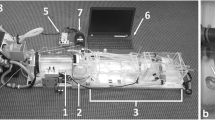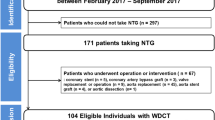Abstract
We developed a new individually customized contrast-injection protocol for coronary computed tomography (CT) angiography based on the time-attenuation response in a test bolus, and investigated its clinical applicability. We scanned 60 patients with suspected coronary diseases using a 64-detector CT scanner, who were randomly assigned to one of two protocols. In protocol 1 (P1), we estimated the contrast dose to yield a peak aortic attenuation of 400 HU based on the time-attenuation response to a small test-bolus injection (0.3 ml/kg body weight) delivered over 9 s. Then we administered a customized contrast dose over 9 s. In protocol 2 (P2), the dose was tailored to the patient’s body weight; this group received 0.7 ml/kg body weight with an injection duration of 9 s. We compared the two protocols for dose of contrast medium, peak attenuation, variations in attenuation values of the ascending aorta, and the success rate of adequate attenuation (250–350 HU) of the coronary arteries. The contrast dose was significantly smaller in P1 than in P2 (36.9 ± 9.2 vs 43.1 ± 7.0 ml, P < 0.01). Peak aortic attenuation was significantly less under P1 than under P2 (384.1 ± 25.0 vs 413.5 ± 45.7, P < 0.01). The mean variation (standard deviation) of the attenuation values was smaller in P1 than in P2 (25.0 vs 45.7, P < 0.01). The success rate of adequate attenuation of the coronary arteries was significantly higher with P1 than with P2 (85.0 vs 65.8 %, P < 0.01). P1 facilitated a reduction in the contrast dose, reduced the individual variations in peak aortic attenuation, and achieved optimal coronary CT attenuation (250–350 HU) more frequently than P2.





Similar content being viewed by others
References
Cademartiri F, Mollet NR, Lemos PA, Saia F, Midiri M, de Feyter PJ, Krestin GP (2006) Higher intracoronary attenuation improves diagnostic accuracy in MDCT coronary angiography. AJR Am J Roentgenol 187(4):W430–W433
Cademartiri F, Maffei E, Palumbo AA, Malago R, La Grutta L, Meiijboom WB, Aldrovandi A (2008) Influence of intra-coronary enhancement on diagnostic accuracy with 64-slice CT coronary angiography. Eur Radiol 18(3):576–583
Horiguchi J, Fujioka C, Kiguchi M, Shen Y, Althoff CE, Yamamoto H, Ito K (2007) Soft and intermediate plaques in coronary arteries: how accurately can we measure CT attenuation using 64-MDCT? AJR Am J Roentgenol 189(4):981–988
Fei X, Du X, Yang Q, Shen Y, Li P, Liao J, Li K (2008) 64-MDCT coronary angiography: phantom study of effects of vascular attenuation on detection of coronary stenosis. AJR Am J Roentgenol 191(1):43–49
Yamamuro M, Tadamura E, Kanao S, Wu YW, Tambara K, Komeda M, Toma M (2007) Coronary angiography by 64-detector row computed tomography using low dose of contrast material with saline chaser: influence of total injection volume on vessel attenuation. J Comput Assist Tomogr 31(2):272–280
Becker CR, Hong C, Knez A, Leber A, Bruening R, Schoepf UJ, Reiser MF (2003) Optimal contrast application for cardiac 4-detector-row computed tomography. Invest Radiol 38(11):690–694
Nakaura T, Awai K, Yauaga Y, Nakayama Y, Oda S, Hatemura M, Nagayoshi Y (2008) Contrast injection protocols for coronary computed tomography angiography using a 64-detector scanner: comparison between patient weight-adjusted- and fixed iodine-dose protocols. Invest Radiol 43(7):512–519
Bae KT, Seeck BA, Hildebolt CF, Tao C, Zhu F, Kanematsu M, Woodard PK (2008) Contrast enhancement in cardiovascular MDCT: effect of body weight, height, body surface area, body mass index, and obesity. AJR Am J Roentgenol 190(3):777–784
Bae KT (2010) Intravenous contrast medium administration and scan timing at CT: considerations and approaches. Radiology 256(1):32–61
Tatsugami F, Kanamoto T, Nakai G, Takeda Y, Morita H, Morinaga I, Yoshikawa S (2010) Reduction of the total injection volume of contrast material with a short injection duration in 64-detector row CT coronary angiography. Br J Radiol 83(985):35–39
Nakaura T, Awai K, Yanaga Y, Namimoto T, Utsunomiya D, Hirai T, Sugiyama S (2011) Low-dose contrast protocol using the test bolus technique for 64-detector computed tomography coronary angiography. Jpn J Radiol 29(7):457–465
Tomizawa N, Nojo T, Akahane M, Torigoe R, Kiryu S, Ohtomo K (2012) Shorter delay time reduces interpatient variability in coronary enhancement in coronary CT angiography using the bolus tracking method with 320-row CT. Int J Cardiovasc Imaging
Takahashi S, Murakami T, Takamura M, Kim T, Hori M, Narumi Y, Nakamura H (2002) Multi-detector row helical CT angiography of hepatic vessels: depiction with dual-arterial phase acquisition during single breath hold. Radiology 222(1):81–88
Raman SS, Pojchamarnwiputh S, Muangsomboon K, Schulam PG, Gritsch HA, Lu DS (2006) Utility of 16-MDCT angiography for comprehensive preoperative vascular evaluation of laparoscopic renal donors. AJR Am J Roentgenol 186(6):1630–1638
Isogai T, Jinzaki M, Tanami Y, Kusuzaki H, Yamada M, Kuribayashi S (2011) Body weight-tailored contrast material injection protocol for 64-detector row computed tomography coronary angiography. Jpn J Radiol 29(1):33–38
Yanaga Y, Awai K, Nakaura T, Oda S, Funama Y, Bae KT, Yamashita Y (2009) Effect of contrast injection protocols with dose adjusted to the estimated lean patient body weight on aortic enhancement at CT angiography. AJR Am J Roentgenol 192(4):1071–1078
Zhu X, Zhu Y, Xu H, Tang L, Xu Y (2012) The influence of body mass index and gender on coronary arterial attenuation with fixed iodine load per body weight at dual-source CT coronary angiography. Acta Radiol 53(6):637–642
Yanaga Y, Awai K, Nakaura T, Utsunomiya D, Oda S, Hirai T, Yamashita Y (2010) Contrast material injection protocol with the dose adjusted to the body surface area for MDCT aortography. AJR Am J Roentgenol 194(4):903–908
Salgado RA, Spinhoven M, De Jongh K, Op de Beeck B, Corthouts B, Parizel PM (2007) Chest MSCT acquisition and injection protocols. JBR-BTR 90(2):97–99
Fleischmann D (2003) Use of high concentration contrast media: principles and rationale-vascular district. Eur J Radiol 45(Suppl 1):S88–S93
Weininger M, Barraza JM, Kemper CA, Kalafut JF, Costello P, Schoepf UJ (2011) Cardiothoracic CT angiography: current contrast medium delivery strategies. AJR Am J Roentgenol 196(3):W260–W272
Cademartiri F, Mollet NR, van der Lugt A, McFadden EP, Stijnen T, de Feyter PJ, Krestin GP (2005) Intravenous contrast material administration at helical 16-detector row CT coronary angiography: effect of iodine concentration on vascular attenuation. Radiology 236(2):661–665
Schoepf UJ, Zwerner PL, Savino G, Herzog C, Kerl JM, Costello P (2007) Coronary CT angiography. Radiology 244(1):48–63
Johnson TR, Nikolaou K, Wintersperger BJ, Fink C, Rist C, Leber AW, Knez A (2007) Optimization of contrast material administration for electrocardiogram-gated computed tomographic angiography of the chest. J Comput Assist Tomogr 31(2):265–271
Fleischmann D (2003) Use of high-concentration contrast media in multiple-detector-row CT: principles and rationale. Eur Radiol 13(Suppl 5):M14–M20
Bae KT, Heiken JP, Brink JA (1998) Aortic and hepatic contrast medium enhancement at CT. Part I. Prediction with a computer model. Radiology 207(3):647–655
Awai K, Hiraishi K, Hori S (2004) Effect of contrast material injection duration and rate on aortic peak time and peak enhancement at dynamic CT involving injection protocol with dose tailored to patient weight. Radiology 230(1):142–150
Flinck M, Graden A, Milde H, Flinck A, Hellstrom M, Bjork J, Nyman U (2010) Cardiac output measured by electrical velocimetry in the CT suite correlates with coronary artery enhancement: a feasibility study. Acta Radiol 51(8):895–902
Bae KT, Heiken JP, Brink JA (1998) Aortic and hepatic contrast medium enhancement at CT. Part II. Effect of reduced cardiac output in a porcine model. Radiology 207(3):657–662
Platt JF, Reige KA, Ellis JH (1999) Aortic enhancement during abdominal CT angiography: correlation with test injections, flow rates, and patient demographics. AJR Am J Roentgenol 172(1):53–56
Heiken JP, Brink JA, McClennan BL, Sagel SS, Crowe TM, Gaines MV (1995) Dynamic incremental CT: effect of volume and concentration of contrast material and patient weight on hepatic enhancement. Radiology 195(2):353–357
Bae KT (2003) Peak contrast enhancement in CT and MR angiography: when does it occur and why? Pharmacokinetic study in a porcine model. Radiology 227(3):809–816
Bassingthwaighte JB (1967) Circulatory transport and the convolution integral. Mayo Clin Proc 42(3):137–154
Mahnken AH, Rauscher A, Klotz E, Muhlenbruch G, Das M, Gunther RW, Wildberger JE (2007) Quantitative prediction of contrast enhancement from test bolus data in cardiac MSCT. Eur Radiol 17(5):1310–1319
Fleischmann D, Hittmair K (1999) Mathematical analysis of arterial enhancement and optimization of bolus geometry for CT angiography using the discrete Fourier transform. J Comput Assist Tomogr 23(3):474–484
Conflict of interest
None.
Author information
Authors and Affiliations
Corresponding author
Rights and permissions
About this article
Cite this article
Kidoh, M., Nakaura, T., Nakamura, S. et al. Novel contrast-injection protocol for coronary computed tomographic angiography: contrast-injection protocol customized according to the patient’s time-attenuation response. Heart Vessels 29, 149–155 (2014). https://doi.org/10.1007/s00380-013-0338-x
Received:
Accepted:
Published:
Issue Date:
DOI: https://doi.org/10.1007/s00380-013-0338-x




